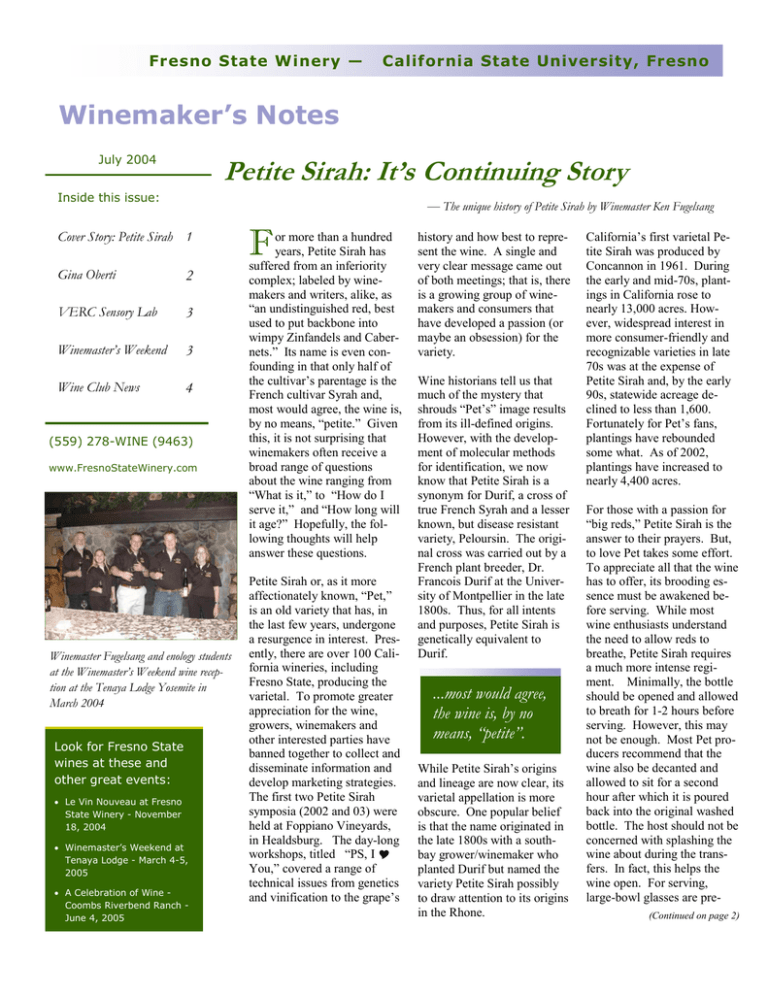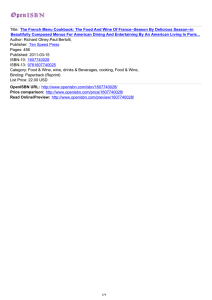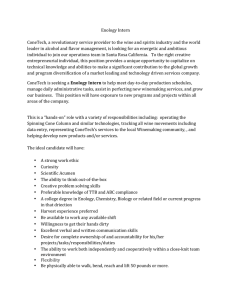F
advertisement

Fresno State Winery — California State University, Fresno Winemaker’s Notes July 2004 Petite Sirah: It’s Continuing Story Inside this issue: — The unique history of Petite Sirah by Winemaster Ken Fugelsang Cover Story: Petite Sirah 1 Gina Oberti 2 VERC Sensory Lab 3 Winemaster’s Weekend 3 Wine Club News 4 (559) 278-WINE (9463) www.FresnoStateWinery.com Winemaster Fugelsang and enology students at the Winemaster’s Weekend wine reception at the Tenaya Lodge Yosemite in March 2004 Look for Fresno State wines at these and other great events: • Le Vin Nouveau at Fresno State Winery - November 18, 2004 • Winemaster’s Weekend at Tenaya Lodge - March 4-5, 2005 • A Celebration of Wine Coombs Riverbend Ranch June 4, 2005 F or more than a hundred years, Petite Sirah has suffered from an inferiority complex; labeled by winemakers and writers, alike, as “an undistinguished red, best used to put backbone into wimpy Zinfandels and Cabernets.” Its name is even confounding in that only half of the cultivar’s parentage is the French cultivar Syrah and, most would agree, the wine is, by no means, “petite.” Given this, it is not surprising that winemakers often receive a broad range of questions about the wine ranging from “What is it,” to “How do I serve it,” and “How long will it age?” Hopefully, the following thoughts will help answer these questions. Petite Sirah or, as it more affectionately known, “Pet,” is an old variety that has, in the last few years, undergone a resurgence in interest. Presently, there are over 100 California wineries, including Fresno State, producing the varietal. To promote greater appreciation for the wine, growers, winemakers and other interested parties have banned together to collect and disseminate information and develop marketing strategies. The first two Petite Sirah symposia (2002 and 03) were held at Foppiano Vineyards, in Healdsburg. The day-long workshops, titled “PS, I You,” covered a range of technical issues from genetics and vinification to the grape’s history and how best to represent the wine. A single and very clear message came out of both meetings; that is, there is a growing group of winemakers and consumers that have developed a passion (or maybe an obsession) for the variety. Wine historians tell us that much of the mystery that shrouds “Pet’s” image results from its ill-defined origins. However, with the development of molecular methods for identification, we now know that Petite Sirah is a synonym for Durif, a cross of true French Syrah and a lesser known, but disease resistant variety, Peloursin. The original cross was carried out by a French plant breeder, Dr. Francois Durif at the University of Montpellier in the late 1800s. Thus, for all intents and purposes, Petite Sirah is genetically equivalent to Durif. ...most would agree, the wine is, by no means, “petite”. While Petite Sirah’s origins and lineage are now clear, its varietal appellation is more obscure. One popular belief is that the name originated in the late 1800s with a southbay grower/winemaker who planted Durif but named the variety Petite Sirah possibly to draw attention to its origins in the Rhone. California’s first varietal Petite Sirah was produced by Concannon in 1961. During the early and mid-70s, plantings in California rose to nearly 13,000 acres. However, widespread interest in more consumer-friendly and recognizable varieties in late 70s was at the expense of Petite Sirah and, by the early 90s, statewide acreage declined to less than 1,600. Fortunately for Pet’s fans, plantings have rebounded some what. As of 2002, plantings have increased to nearly 4,400 acres. For those with a passion for “big reds,” Petite Sirah is the answer to their prayers. But, to love Pet takes some effort. To appreciate all that the wine has to offer, its brooding essence must be awakened before serving. While most wine enthusiasts understand the need to allow reds to breathe, Petite Sirah requires a much more intense regiment. Minimally, the bottle should be opened and allowed to breath for 1-2 hours before serving. However, this may not be enough. Most Pet producers recommend that the wine also be decanted and allowed to sit for a second hour after which it is poured back into the original washed bottle. The host should not be concerned with splashing the wine about during the transfers. In fact, this helps the wine open. For serving, large-bowl glasses are pre(Continued on page 2) Page 2 (559) 278-WINE (9463) Gina Oberti: 2004 Undergraduate Achievement Award Recipient M Retiring Enology Society Officers Stephanie Sorn (left), Gina Oberti (middle) and Brian Cheeseborough Congratulations 2004 Viticulture and Enology Graduates! oving to Fresno was an exciting experience, since I had never lived away from home before. I was both nervous and excited at this new opportunity. The moment I entered the Department of Viticulture and Enology it felt so friendly, so warm. The faculty and staff are wonderful because they genuinely care about each student. The students in this program have so much fun together and challenge each other to learn more. The Enology Society and Viticulture Club help contribute to this camaraderie. I was extremely nervous when I attended my first Enology Society tasting. I hardly knew anyone and had never been to a tasting before. The students were so friendly and made me feel comfortable and relaxed. The atmosphere they provided was open and comfortable. I was able to learn and ask questions about wine sensory and the winemaking process. I had such a great time that night that I became a member and soon became involved. In -By Gina Oberti, Enology Graduate the 2002-2003 school year, I wine is being made. I got an was elected secretary of the excellent chance to ask quesEnology Society and in the tions from Ken, the Winemas2003-2004 school year, I was ter, and Kevin, the Wineelected president. Each year maker. This helped me to the Enology Society continues understand the classroom to learn and improve from the discussions and to develop previous year. As president, I my own winemaking style. I tried to make the tastings was able to see winemaking open and friendly to students, from the grape right to the faculty and also people from bottle. I worked on harvest the community. I wanted sampling and determining them to get as great of an exwhen the grapes came in for perience and learn as much as processing. I monitored ferI have from the weekly tastmentations and learned when ings. I feel that with such an it was a good time to press off open atmosphere people feel the skins. After crush, I profree to express themselves gressed to the barrel room to and ask questions without learn barrel maintenance and fear. I love to get input from how wine matures and members of the society as the changes in the barrels. Just tastings occur to get the most seeing the difference of the out of each tasting. Many same wine in different barrels people in the society have allowed me to see what an experiences that I have not affect barrels have on wine. had and allowing everyone to The chance to work in the contribute allows us all to school winery while I was learn. attending was so helpful. I was able to learn so much in Working my two crushes in class and implement it in a the Fresno State Winery hands-on manner. helped me to learn so much about the process of wineAfter seeing the grapes go making and the many things from the field to the bottle, I that must be thought of as was also able to see the busi(Continued on page 4) (Continued from page 1) ferred. Again, plenty of surface area equates to continued opportunity for oxygen permeation and development of aromatic and flavor profiles. Fresno State’s award-winning 2001 Petite Sirah is true to style; an assertive red with ink-black color and a core of supple, yet powerful, tannins. Rich blackberry and jam flavors followed by black pepper, clove and nutmeg follow and evolve across the palate. Fresno State’s award winning “Pet” Pet will easily age for 10-15 years. So, if you’re looking for the perfect wine to serve at your child’s wedding, or grandchildren’s college graduation, try Fresno State Petite Sirah! Fresno State student winemakers processing Petite Sirah (559) 278-WINE (9463) Page 3 A 99 Point Gold?!: Fresno State’s New Sensory Lab T he Viticulture and Enology Research Center opened a new Sensory Lab in spring 2004 under the direction of Dr. Susan Rodriquez. A “kitchen” in Viticulture & Enology North has been remodeled into a state-ofthe-art sensory laboratory. Forty people were screened in January and February to obtain our first panel of 22. When selected to participate on the panel, panelists were asked to abide by certain “rules”, e.g. not to eat or drink anything for an hour before their session meets. Panelists were trained for several weeks before starting the wine evaluation and attend two hourly sessions per week. The lab is divided into two sections: the sample prep area and the tasting area. Panelists are not able to see into the prep area (equipped with a refrigerator, dishwasher, and plenty of bench space to prepare the wine samples). The room is as “neutral” as possible: it has been painted white, the booths are white, there are blinds on the windows, and there is adjustable, daylight lighting. The booths provide panelists with the privacy and lack of distraction which is needed for their work. Each of the five booths is computerized, using specialized sensory evaluation software and flat-screen monitors. Panelists’ results are automatically recorded and analyzed on the master computer in the prep area. A waiting room area with table, chair and magazines, just outside of the lab, is provided for panelists who arrive early. Currently we are running tests on Chardonnay wines that are designed to answer the “simple” question, “Is Chardonnay ‘A’ different taste and/or aroma-wise from wine ‘B’?” This is a very important question because a winery may decide to make an expensive change in its wine- -Submitted by Dr. Susan Rodriguez, Research Fellow making process dependent on the outcome. For these tests panelists receive three wine samples in glasses labeled with random 3-digit numbers through a little door in their booth. Two of the samples are the same Chardonnay; the other sample is a different Chardonnay. Panelists smell and taste the wines at their own speed. When the panelist is ready, he or she selects the wine that seems different from the other two. We rely on statistics to analyze the data, e.g. a minimum number of panelists must correctly identify the “different” sample out Susan Rodriguez and graduate of the three samples presented to student, Linda Baehr preparing conclude that the two Chardonnay samples to be used in the sensory wines are different. Being a panel- panel. ist for the VERC Sensory Laboratory is a very important function. We rely on our trained panelists for accurate characterization of wines made here at Fresno State and for For more information on the new the evaluation of wines on a comVERC Sensory Lab, contact mercial basis for private compaDr. Susan Rodriguez at nies. susanr@csufresno.edu Winemaster’s Weekend In Review - March 5-7, 2004 T he third annual Winemaster’s Weekend, held at the Tenaya Lodge, was a success, again, this year. The expanded two-day venue began Friday evening with a wine reception in the foyer hosted by Fresno State. After guests had an opportunity to unwind, Clark Smith of Vinovation led a Wine and Music Pairing workshop. If you are skeptical as to whether music influences your perception of wine, you should have attended this demonstration! Saturday morning featured a Barrel Making demonstration led by Steve Tillman and his master cooper from Mendocino Cooperage. The session also featured Fresno State sausage and Port wine. It’s always fascinating to watch a Guests relax with Fresno State wines and soothing tunes during the Music and Wine Pairing at Tenaya Lodge. cooper at work, and this occasion was no exception. Along with Steve’s narrative, guests left with new (or renewed) appreciation of the craftsmanship and artistry involved in making a wine barrel. That afternoon, guests were treated to a Food and Wine Pairing led by the Tenaya Lodge’s Master Chef, Fredrick Clabaugh, Fresno State Associate Professor and Winemaster, Ken Fugelsang and wine-writer, Mike Stepanovich. The weekend concluded with a sevencourse banquet pairing select Fresno State wines and other food products with selected creations by Chef Clabaugh and his staff. The evening finished with a raffle of all Fresno State wines served that weekend. If you couldn’t make this year’s event, the fourth-annual weekend is already scheduled. We hope to see you there! 2005 Winemaster’s Weekend at Tenaya Lodge Friday and Saturday, March 4-5, 2005 Check our website for upcoming details and special weekend package rates Wine Club News • Are you enjoying the warm sunshine and summer weather? Whether at a backyard BBQ or any social activity, don’t forget to bring along some Fresno State wine! • Do we have your correct shipping address? email address? billing information? Please send all information changes to the attention of Kevin Connor at jgiannini@csufresno.edu. • If you love receiving your wine club shipments, why not share the joy with a friend? Wine Club subscriptions are great for birthdays, anniversaries, retirements and more! • Remember Wine Club members receive a 15% discount on all online wine orders! (Continued from page 2) volunteered for wine tastings for the Fresno State Winery. This gave me a chance to practice speaking to consumers about the wines that I helped make. I learned how to communicate my knowledge of winemaking and make it interesting to the public. I also got to see what kind of preferences consumers had and how I could target these preferences. Learning to communicate effectively to your market is so important and this is a fun way to practice. The great thing about the program is everyone’s passion for grape growing and winemaking. The students are always thinking and asking questions and the faculty are always teaching and listening. I have never felt uncomfortable to ask a question, and I have always gotten a response. I have been able to learn so much and participate in so many events that help prepare me for when I graduate. The Viticulture and Enology program helps students develop their minds and their skills preparing them for their future. Because of the great atmosphere, I was able to grow and be challenged. This helped me to be the best student I could be. Viticulture Club and Enology Society members gather for a photo at their annual Bud Break BBQ. Introducing Our New Winemaker, John Giannini! 2360 E. Barstow M/S VR89 Fresno, CA 93740-8003 Phone: 559 278-WINE (9463) Fax: 559 278-6619 Email: jgiannini@csufresno.edu F resno State Winery is pleased to announce that John Giannini joined California State University, Fresno on July 7, 2004 as its new winemaker. ORDER WINE ON THE WEB W W W . F R E S N O S TAT E W I N E RY . C O M John completed the enology program at California State University, Fresno in 1999. His winemaking experience includes the Taft Street Winery in Sebastopol and Wild Horse Winery in Templeton, California. He has a BS degree from Virginia State University and was the owner and operator and of a small business in Richmond, Virginia before coming to Fresno in the late 90’s to study enology. During this busy time of year, John has hit the ground running in the winery! His winemaking and custom crush experience will be an asset to Fresno State. Please join us in welcoming John to Fresno.


